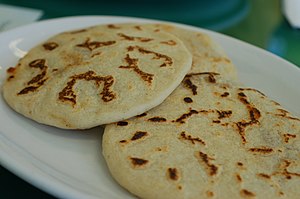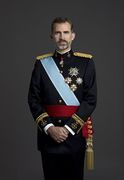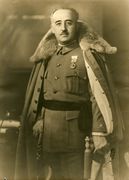Culture of Creeperopolis
| Part of a series on the |
| Culture of Creeperopolis |
|---|
 |
| Society |
| Topics |
| Symbols |

Culture in Creeperopolis dominates the country and is heavy in both traditionalist Creeperian influences. A new composite population was formed as a result of intermarrying between the native Creeperian population with the Salvadorans and Castillianans. The Creeperian Catholic Church plays an important role in the Creeperian culture. Creeperian in the dominant language in Creeperia culture.
Contents
National Symbols
| Type | Symbol | Year | Image |
|---|---|---|---|
| Anthem | Himno Imperial Creeperiano |
1845/1933 | |
| Flag and Coat of arms | Coat of Arms of Creeperopolis and Flag of Creeperopolis |
1845/1933 | |
| Color | Black, White, and Gold |
1231 | 
|
| Bird | Águila Oro |
1949 | 
|
| National Dish | Pupusa |
1231 | 
|
| Flower | Yucca gigantea |
1887 | 
|
| Tree | Tabebuia rosea |
1887 | 
|
| Patron and National Personification | Monumento del Salvador del Mundo y la'Humanidad |
1968 | 
|
Languages
In Creeperopolis, Creeperian, specificially Creeperian, is the official and dominant language. Other variations of Spanish spoken are Castillianan, Salvadoran, and Atlántidan Spanish. Other languages spoken include Quebecshirite, Senvarian, Sonsatepanian, and Deltinian.
Sports

Creeperans are known for their heavy love for soccer, called fútbol, and their notable talent in the sport. Fútbol is the largest and most popular sport in Creeperopolis with fútbol being played by all ages, all ethnic groups, and both genders.
Fútbol is a common during and after school activity for children in elemenatary and middle school and remains a common after school activity for high school and college age students. There are several private and public fútbol clubs for high school and college age students to participate in. Nearly 4 out of every 5 children in Creeperopolis say that they either play fútbol or enjoy watching a game of fútbol.
The National Football Association (Asociación Nacional de Fútbol, ANF) is the largest sporting organization in Creeperopolis and is composed of sixteen professional fútbol clubs. The Copa Creeperiano is held every year to decide the champion of the ANF with the Santos de San Salvador being the current Copa Creeperiano champions. Players from the sixteen ANF teams are selected to play on the Creeperopolis National Fútbol Team to play in the annual Terraconservan Cup, of which the Creeperopolis National Fútbol Team is the reigning champion.
Religion
The majority of the population in Creeperopolis is Christian, Creeperian Catholicism at 92%. Emperor Romero I was canonized as a saint in 1983 by Pope St. Juan Pablo II.
The remaining 8% are either Senvarian Protestants (mainly found in the Senvar and Sonsatepan departments), Irreligious (mostly from the Quebecshirite poplaiton in Puerto Francisco), and Deltinian Islam (mostly in the San Juan department).
Hammocks
Creeperopolis is a hammock cultured country and a large producer and exporter of hammocks. Hammocks are a big part of Creeperian culture and are often used for afternoon naps. Hammocks swing from doorways, inside living rooms, on porches, in outdoor courtyards, and from trees. Just about everywhere a hammock can be seen hung in all social classes of Creeperian homes. It is completely socially acceptable to lay around in a hammock all day.
Public Holidays
Creeperopolis celebrates several public holidays, most of which being political, religious, or cultural. The official list of public holidays was last updated in 2010. Many Creeperans do not work on public holidays and those who do are often paid overtime.
| Date | Name | Local Name | Observance |
|---|---|---|---|
| February 8 | Independence Day | Día de Independencia | A celebration of the establishment of the modern kingdom of Creeperopolis and the beginning of the Creeperian Crusade. |
| March/April | Holy Week/Easter | Semana Santa/Pascua | Celebrated with Carnival-like events in different cities by the large Creeperian Catholic population. |
| May 3 | The Day of the Cross/Festival of the Crosses | Día de la'Cruz/Fiesta de los'Cruces | The Day of the Cross is a celebration with Old Kingdom origins linked to the advent of the rainy season. People decorate a cross in their yards with fruit and garlands, in the belief that if they do not, the devil will appear and dance at their yard. They then go from house to house to kneel in front of the altar and make the sign of the cross. |
| May 10 | Mother's Day | Día de las'Madres | A day to celebrate motherhood, similar to many other countries Mother's Day. |
| June 17 | Father's Day | Día de los'Padres | A day to celebrate fatherhood, similar to other countries Father's Day. |
| August 23 | Triumvurate Day | Día del Triunvirato | Remembers the Trimvurate of the Catholic Royalist Party consisting of Antonio Sáenz Heredia, Alfonso García Valdecasas, and Julio Alda Miqueleiz. The day falls on the anniversary of the Triumvurate Massacre of 1936. |
| September 15 | Day of the Creeperans/Coronation Day | Día de los'Creeperianos/Día de Coronación | Celebrates the establishment of the Kingdom of Creeperia in 537. It is also the traditional date of the coronation of a new King/Emperor (last celebrated in 2003). |
| September 30 | Feast Day of St. Romero I | Día Festivo de San Romero I | Celebration and remembrance of Emperor Saint Romero I "the Martyr", patron saint of Creeperopolis, and a day of remembrance for the conclusion of the Creeperian Civil War. |
| October 1 | Children's Day | "Día de los'niños" | Celebration dedicated to the Children of the country, celebrated across the country. |
| November 1 | All Saints' Day | Día de los'Santos | A day when most people celebrate their patron saints and attend mass. |
| November 2 | Day of the Dead | Día de los'Muertos | A day when most people visit the tombs of deceased loved ones. |
| November 7–13 | National Pupusa Festival | Festival Nacional de la'Pupusa | This week is the national commemoration of the national food (Pupusa). |
| December 25 | Christmas Day/Crusaders' Day | Navidad/Día del Cruzadore | December 25 is marked as the traditional date of birth of Jesús Cristo in Creeperian Catholic tradition. It is also the day that marks the end of the Creeperian Crusade. |
| December 31 | New Year's Eve | Fin del Año | The final day of the year, and the day before New Year's Day is celebrated in Creeperopolis with family reunions. |
Cuisine

One of Creeperopolis' notable dishes is the pupusa. Pupusas are handmade corn tortillas (made of masa de maíz or masa de arroz, a maize or rice flour dough used in Creeperian cuisine) stuffed with one or more of the following: cheese (usually a soft Creeperian cheese such as quesillo, similar to mozzarella), chicharrón, or refried beans. Sometimes the filling is queso con loroco (cheese combined with loroco, a vine flower bud native to Creeperopolis).
Pupusas revueltas are pupusas filled with beans, cheese and pork. Some coastal restaurants even offer pupusas stuffed with shrimp or fish. The precise origins of the pupusa are debated, although its presence in Creeperopolis is known to predate the establishment of the Old Kingdom
Two other typical Creeperian dishes are yuca frita and panes con pollo. Yuca frita is deep fried cassava root served with curtido (a pickled cabbage, onion and carrot topping) and pork rinds with pescaditas (fried baby sardines). The Yuca is sometimes served boiled instead of fried. Pan con pollo/pavo (bread with chicken/turkey) are warm chicken-filled submarine sandwiches. The bird is marinated and then roasted with Castillianan spices and handpulled. This sandwich is traditionally served with tomato and watercress along with cucumber, onion, lettuce, mayonnaise, and mustard.
One of Creeperopolis' typical breakfasts is fried platanos (plantain/bananas), usually served with cream or sugar.
"Maria Luisa" is a dessert commonly found in Creeperopolis. It is a layered cake that is soaked in orange marmalade and sprinkled with powdered sugar.
A popular drink that Creeperans enjoy is orchata, a drink native to the Salvador. Orchata is most commonly made of the morro seed ground into a powder and added to milk or water, and sugar. Orchata is drank year-round, and can be drank at any time of day. It mostly is accompanied by a plate of pupusas or fried yuca. Orchata from Creeperopolis has a very distinct taste and is not to be confused with Atlántidan orchata, which is rice-based. Coffee is also a common morning beverage.
Other popular drinks in Creeperopolis include Ensalada, a drink made of chopped fruit swimming in fruit juice, and Kolachampan, a sugar cane-flavored carbonated beverage.
One of the most popular desserts is the cake Pastel de tres leches (Cake of three milks), consisting of three types of milk: evaporated milk, condensed milk, and cream.
Notable Creeperian People
- Carlos Calleja.jpg
Valentín Elizalde Valencia
MusicianRodolfo Zelaya García
Fútbol PlayerOrlando Pareja Palau
Professor

























